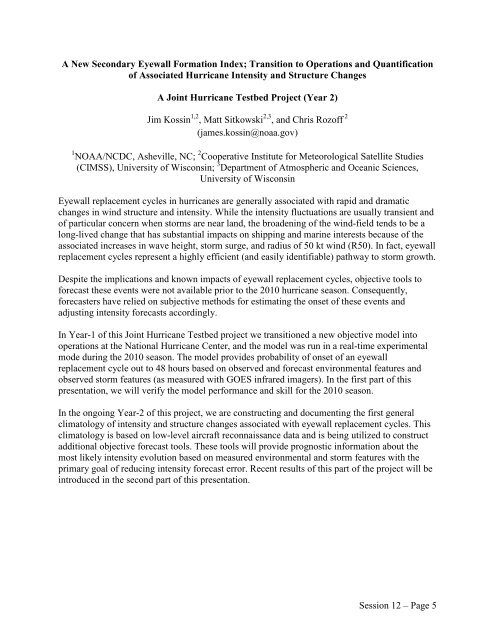65th IHC Booklet/Program (pdf - 4.9MB) - Office of the Federal ...
65th IHC Booklet/Program (pdf - 4.9MB) - Office of the Federal ...
65th IHC Booklet/Program (pdf - 4.9MB) - Office of the Federal ...
You also want an ePaper? Increase the reach of your titles
YUMPU automatically turns print PDFs into web optimized ePapers that Google loves.
A New Secondary Eyewall Formation Index; Transition to Operations and Quantification<br />
<strong>of</strong> Associated Hurricane Intensity and Structure Changes<br />
A Joint Hurricane Testbed Project (Year 2)<br />
Jim Kossin 1,2 , Matt Sitkowski 2,3 , and Chris Roz<strong>of</strong>f 2<br />
(james.kossin@noaa.gov)<br />
1 NOAA/NCDC, Asheville, NC; 2 Cooperative Institute for Meteorological Satellite Studies<br />
(CIMSS), University <strong>of</strong> Wisconsin; 3 Department <strong>of</strong> Atmospheric and Oceanic Sciences,<br />
University <strong>of</strong> Wisconsin<br />
Eyewall replacement cycles in hurricanes are generally associated with rapid and dramatic<br />
changes in wind structure and intensity. While <strong>the</strong> intensity fluctuations are usually transient and<br />
<strong>of</strong> particular concern when storms are near land, <strong>the</strong> broadening <strong>of</strong> <strong>the</strong> wind-field tends to be a<br />
long-lived change that has substantial impacts on shipping and marine interests because <strong>of</strong> <strong>the</strong><br />
associated increases in wave height, storm surge, and radius <strong>of</strong> 50 kt wind (R50). In fact, eyewall<br />
replacement cycles represent a highly efficient (and easily identifiable) pathway to storm growth.<br />
Despite <strong>the</strong> implications and known impacts <strong>of</strong> eyewall replacement cycles, objective tools to<br />
forecast <strong>the</strong>se events were not available prior to <strong>the</strong> 2010 hurricane season. Consequently,<br />
forecasters have relied on subjective methods for estimating <strong>the</strong> onset <strong>of</strong> <strong>the</strong>se events and<br />
adjusting intensity forecasts accordingly.<br />
In Year-1 <strong>of</strong> this Joint Hurricane Testbed project we transitioned a new objective model into<br />
operations at <strong>the</strong> National Hurricane Center, and <strong>the</strong> model was run in a real-time experimental<br />
mode during <strong>the</strong> 2010 season. The model provides probability <strong>of</strong> onset <strong>of</strong> an eyewall<br />
replacement cycle out to 48 hours based on observed and forecast environmental features and<br />
observed storm features (as measured with GOES infrared imagers). In <strong>the</strong> first part <strong>of</strong> this<br />
presentation, we will verify <strong>the</strong> model performance and skill for <strong>the</strong> 2010 season.<br />
In <strong>the</strong> ongoing Year-2 <strong>of</strong> this project, we are constructing and documenting <strong>the</strong> first general<br />
climatology <strong>of</strong> intensity and structure changes associated with eyewall replacement cycles. This<br />
climatology is based on low-level aircraft reconnaissance data and is being utilized to construct<br />
additional objective forecast tools. These tools will provide prognostic information about <strong>the</strong><br />
most likely intensity evolution based on measured environmental and storm features with <strong>the</strong><br />
primary goal <strong>of</strong> reducing intensity forecast error. Recent results <strong>of</strong> this part <strong>of</strong> <strong>the</strong> project will be<br />
introduced in <strong>the</strong> second part <strong>of</strong> this presentation.<br />
Session 12 – Page 5
















